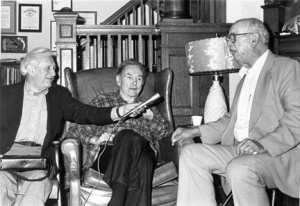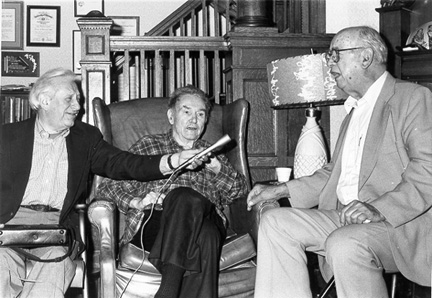
Airshow’s Restoration Center for Audio Archives regularly works with analog tape-based oral histories, and we note repeatedly that interviews from the pre-digital era exhibit some of the same limitations my work exhibited years ago. More recently, technology updates and an emphasis on sharing best practices help enthusiasts and pros get better results from their oral history interviews.
In this short post, I share some of the best resources from oral history professionals’ many web sites and some information from pro audio sources. I found it helpful to consider both pro audio and pro interviewer perspectives in compiling this short list of suggestions.
In “A Time to Give,” by recording engineer and educator Paul Stamler in the December 2012 issue of Recording Magazine, Paul tells pro and semi-pro engineers how to conduct a family oral history interview. Some of the tips here are drawn from his well-written primer.
Professional Preparation
I found a very useful, three-page best practices document on oral history interviewing created by the Bancroft Library at UC-Berkeley. Any regular listener to Terry Gross on “Fresh Air” will recognize the value of these tips:
• Know your subject matter but limit your own remarks.
• Plan your interview with an emphasis on open-ended questions, and think in advance about what follow-up questions might be useful. Be prepared for tangents, and take advantage of them.
• Establish the subject’s place at every point in the story; know if you are talking with an eyewitness. Probe for accuracy without confronting.
• If possible, conduct interview sessions that are no longer than an hour, and be prepared to stop and reschedule if your subject is fatigued, losing interest, or losing his or her voice.
Technical Preparation
• Choose the right recorder and mics. If you are lucky enough to be the one to spec the gear or buy the gear, you will find a range of affordable, highly portable options. In addition to offering an interface that is easy to learn and then use on the fly, your recorder should have plenty of storage. (For example, 4 GB internal storage translates to just two hours of recording two channels at 24/96 resolution). It should have both long-lasting batteries AND an external power cord. If you are going to be limited to using just the recorder’s built-in stereo mics, then be sure the reviews of the mics are positive! If you have the option to add mics, Paul recommends two wired lavalier (“lav” for short) mics.
The website, Oral History in the Digital Age, offers an interactive tool from to help select gear. “Ask Doug” by oral historian and Airshow client Doug Boyd enables you to set your price or feature parameters and will then select from among current gear that fits your specs. http://ohda.matrix.msu.edu/doug/
Popular recorder choices among oral history professionals are the Sony PCM-M10, Zoom H4N or H6, and the Tascam DR-100 MkII.
Recording Magazine is again a good resource, having reviewed many of the most popular portable recorders. We collected some of the reviews for reference as you work with Doug’s selection tool:
Zoom H4n Handy Recorder
Sony PCM-M10
Olympus LS-20M and LS-100
Roland R-05 Portable Recorder
For mics, both Paul and Doug caution that you get what you pay for in terms of quality. Doug’s two lav mic choices are both AudioTechnica, the AT831b and the lower cost Pro70. Doug has several tabletop and handheld mic recommendations as well.
• Know your equipment. Once you have your mics and your recorder, practice with them! Try different mic placement options; know how to attach a lav mic with confidence. If you are using a recorder’s built-in mics, experiment with placing it at different levels and distances relative to both you and a subject. Practice setting levels, testing record and playback so you can adjust your gear settings easily in front of your subject. Use your headphones for this part of your set-up.
Paul discusses some of the finer points of mic placement in his article:
• If you are using a separate mic on a stand, read what he has to say about its placement relative to the recorder, to avoid phase interference and a “hollow” sound.
• If you are using two lav mics for you and your subject, be sure that they are at least three times as far from each other as the distance from the mic to the subject’s mouth.
• Be sure your subject’s lav mic is on the side of the subject closest to you, so the subject is not turning away from the mic to interact with you.
As for recorder operation, Paul reminds us to place a soft towel between the recorder and the table surface, and to place the controls within your view and reach. Record at 24-bit depth and preferably 96 KHz frequency. Turn off all effects, if the recorder has them, and set the volume manually.
Pro Audio and Pro Oral History Resources
Recording Magazine – http://www.recordingmag.com/
Oral History Association – http://www.oralhistory.org
Oral History in the Digital Age – http://ohda.matrix.msu.edu/
I am immensely impressed by the generous information sharing that goes on in the Association of Recorded Sound Collections – www.arsc-audio.org/

